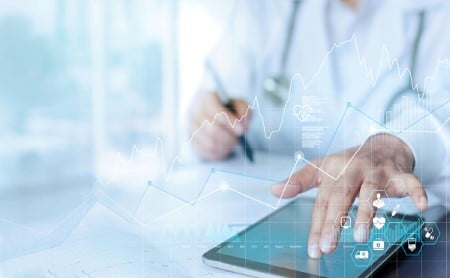How Can Public Health Data Take a Lead Role? Find Out at the COVID-19 TechXpo
March 17, 2021 | J.T. Lane
 For many of us—so worn down after a year of pandemic life—streaming services and binging our favorite shows and films have brought welcome yet temporary relief. Take a moment to consider your favorite film. Recall your favorite characters, plotlines, dialogue, music, and effects. As a fan, your favorite film has the "it" factor.
For many of us—so worn down after a year of pandemic life—streaming services and binging our favorite shows and films have brought welcome yet temporary relief. Take a moment to consider your favorite film. Recall your favorite characters, plotlines, dialogue, music, and effects. As a fan, your favorite film has the "it" factor.
Now, imagine an alternate scenario in which we make a few tweaks to that film. Let’s move the plot climax to the beginning followed by a series of rising actions experienced by the lead character to the end. Imagine further if we recast all the main characters with new actors—who all speak different languages, changed the theme song from smooth jazz to heavy metal, and inserted a few poorly timed explosion special effects.
It is highly likely your film has entirely lost the "it" factor for you and you may never see it again. Creating a film is complex and takes more than the elements mentioned above to create it. It is a thoughtful, planned process that is adequately funded (most of the time) and benefits from the talent and time of thousands of professionals. Though the analogy is not perfect, the parallels with public health data systems are similar. Similar to film and other art forms, public health is ubiquitous. Film and art inspire us, as do the nation’s public health and health care professionals, who have been working around the clock for the last year to prevent illness and save lives.
But the similarities stop with our data systems.
Just like your favorite film that may have provided comfort during this pandemic, public health data systems need a common plot (enterprise-level approaches) to bring cohesion, dialogue (interoperability) to communicate and exchange information, cast (workforce and public-private partnerships), and adequate funding now and over the next decade to execute the vision and ensure the "it" factor for our post-COVID-19 national public health data infrastructure.
While COVID-19 has shown some of the best attributes of the U.S. public health system, it has exposed the weaknesses of our data systems—wrought by chronic underfunding and further exacerbated by siloed, categorical funding and planning. Yet, even with our pandemic weariness and persistent, systemic inequities, this historic event has revealed resiliency across the country. It has also yielded new innovations, along with promising practices and partnerships in how we leverage technology and data to better respond and mitigate public health threats.
To build further momentum and support the ongoing modernization efforts of our partners, ASTHO is hosting its first-ever TechXpo. This year it’s understandably focused on COVID-19, yet we hope it’ll be the first of many to highlight the innovations, promising practices, and lessons learned in our field. Public health data modernization is a 10-year effort, so convening all partners, new and old, to share and discuss our progress is essential.
On March 31, the COVID-19 TechXpo will virtually convene experts from public- and private-sector technology, philanthropic, public health, health care, and data organizations from across the country. Leaders, such as Karen DeSalvo from Google, Jenny Wanger from Linux Foundation Public Health, Este Geraghty from ESRI, Jim Daniel from Amazon, Dylan George from In-Q-Tel, and many others, will share their perspectives on ways public health and technology have engaged to innovate over the last year, what it means for the remainder of the response, and the promising practices that will inform Public Health Data Modernization for the next decade.
Progress on the Ground
Despite our clunky public health data systems, there is ingenuity happening. About half of states have deployed some COVID-19 exposure notification solution to better protect residents, thanks to a novel partnership between the Association of Public Health Laboratories (APHL), Google, Apple, Microsoft, and others. Health departments at all levels are using a variety of symptom tracking and monitoring solutions, including Sara Alert, a solution developed by MITRE and currently deployed in several states and the Northern Mariana Islands. Data is also being leveraged in countless ways to more accurately and timely identify and address racial and geographic disparities. And, with COVID-19 vaccination rates continuing to increase, the development of digital vaccine credentials is underway to further support efforts to re-open communities to large-gathering events and travel.
In the years prior to these innovative responses to the COVID-19 threat, many ASTHO partners in the public health community—including APHL, the Council for State and Territorial Epidemiologists, the National Association of Public Health Statistics and Information Systems, Healthcare Information and Management Systems Society, CDC, and others—issued a report articulating a vision for a modern, 21st century public health data system for the U.S. This vision included:
- Foundational principles of enterprise-level approaches.
- Interoperability of systems.
- Security to protect individual information and common standards.
- A workforce to build and maintain these modern systems.
- Public-private partnerships to fuel the innovation needed to keep the public health data system at the cutting edge.
Luckily, Congress has seen the wisdom in public health data modernization by authorizing funding and establish the Data Modernization Initiative at CDC. We’re making progress even as we respond to this pandemic.
The participants of ASTHO’s inaugural TechXpo represent the collective individuals and sectors we will need to move public health data modernization forward and make it the epic effort to deliver the systems our public health workforce needs for optimal performance. And, even more importantly, the effort will deliver the systems to protect our nation’s communities and families.
We can build a public health data system as inspiring as your favorite film. But it will take effort.